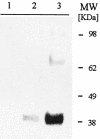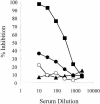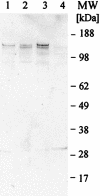Effect of codon optimization on expression levels of a functionally folded malaria vaccine candidate in prokaryotic and eukaryotic expression systems
- PMID: 12933838
- PMCID: PMC187353
- DOI: 10.1128/IAI.71.9.4961-4969.2003
Effect of codon optimization on expression levels of a functionally folded malaria vaccine candidate in prokaryotic and eukaryotic expression systems
Abstract
We have produced two synthetic genes that code for the F2 domain located within region II of the 175-kDa Plasmodium falciparum erythrocyte binding antigen (EBA-175) to determine the effects of codon alteration on protein expression in homologous and heterologous host systems. EBA-175 plays a key role in the process of merozoite invasion into erythrocytes through a specific receptor-ligand interaction. The F2 domain of EBA-175 is the ligand that binds to the glycophorin A receptor on human erythrocytes and is therefore a target of vaccine development efforts. We designed synthetic genes based on P. falciparum, Escherichia coli, and Pichia codon usage and expressed recombinant F2 in E. coli and Pichia pastoris. Compared to the expression of the native F2 sequence, conversion to prokaryote (E. coli)- or eukaryote (Pichia)-based codon usage dramatically improved the levels of recombinant protein expression in both E. coli and P. pastoris. The majority of the protein expressed in E. coli, however, was produced as inclusion bodies. The protein expressed in P. pastoris, on the other hand, was expressed as a secreted, soluble protein. The P. pastoris-produced protein was superior to that produced in E. coli based on its ability to bind to red blood cells. Consistent with these observations, the antibodies generated against the Pichia-produced protein prevented the binding of recombinant EBA to red blood cells. These antibodies recognize EBA-175 present on merozoites as well as in sporozoites by immunofluorescence. Our results suggest that the Pichia-based EBA-F2 vaccine construct has further potential to be developed for clinical use.
Figures








Similar articles
-
Bacterially expressed and refolded receptor binding domain of Plasmodium falciparum EBA-175 elicits invasion inhibitory antibodies.Mol Biochem Parasitol. 2002 Aug 7;123(1):23-33. doi: 10.1016/s0166-6851(02)00122-6. Mol Biochem Parasitol. 2002. PMID: 12165386
-
Evaluation of three Pichia pastoris-expressed Plasmodium falciparum merozoite proteins as a combination vaccine against infection with blood-stage parasites.Infect Immun. 2005 Oct;73(10):6530-6. doi: 10.1128/IAI.73.10.6530-6536.2005. Infect Immun. 2005. PMID: 16177327 Free PMC article.
-
A recombinant baculovirus-expressed Plasmodium falciparum receptor-binding domain of erythrocyte binding protein EBA-175 biologically mimics native protein.Infect Immun. 2000 Jun;68(6):3564-8. doi: 10.1128/IAI.68.6.3564-3568.2000. Infect Immun. 2000. PMID: 10816512 Free PMC article.
-
Recombinant protein vaccines against the asexual blood stages of Plasmodium falciparum.Hum Vaccin. 2010 Jan;6(1):39-53. doi: 10.4161/hv.6.1.10712. Epub 2010 Jan 19. Hum Vaccin. 2010. PMID: 20061790 Review.
-
Erythrocyte glycophorins as receptors for Plasmodium merozoites.Parasit Vectors. 2019 Jun 24;12(1):317. doi: 10.1186/s13071-019-3575-8. Parasit Vectors. 2019. PMID: 31234897 Free PMC article. Review.
Cited by
-
Evolutionary dynamics of codon usages for peste des petits ruminants virus.Front Vet Sci. 2022 Aug 12;9:968034. doi: 10.3389/fvets.2022.968034. eCollection 2022. Front Vet Sci. 2022. PMID: 36032280 Free PMC article.
-
Decoding codon usage in human papillomavirus type 59.Virus Genes. 2025 Jun;61(3):313-323. doi: 10.1007/s11262-025-02148-0. Epub 2025 Mar 4. Virus Genes. 2025. PMID: 40038214 Free PMC article.
-
Cloning, expression, and immunocharacterization of surface protein containing an altered thrombospondin repeat domain (SPATR) from Plasmodium knowlesi.Malar J. 2013 Jun 4;12:182. doi: 10.1186/1475-2875-12-182. Malar J. 2013. PMID: 23734702 Free PMC article.
-
Codon-Optimized NADH Oxidase Gene Expression and Gene Fusion with Glycerol Dehydrogenase for Bienzyme System with Cofactor Regeneration.PLoS One. 2015 Jun 26;10(6):e0128412. doi: 10.1371/journal.pone.0128412. eCollection 2015. PLoS One. 2015. PMID: 26115038 Free PMC article.
-
Optimized expression of Plasmodium falciparum erythrocyte membrane protein 1 domains in Escherichia coli.Malar J. 2004 Dec 15;3:50. doi: 10.1186/1475-2875-3-50. Malar J. 2004. PMID: 15601471 Free PMC article.
References
-
- Baird, J. K. 1995. Host age as a determinant of naturally acquired immunity to Plasmodium falciparum. Parasitol. Today 11:105-111. - PubMed
-
- Brady, C. P., R. L. Shimp, A. P. Miles, M. Whitmore, and A. W. Stowers. 2001. High-level production and purification of P30P2MSP1(19), an important vaccine antigen for malaria, expressed in the methylotropic yeast Pichia pastoris. Protein Expr. Purif. 23:468-475. - PubMed
-
- Camus, D., and T. J. Hadley. 1985. A Plasmodium falciparum antigen that binds to host erythrocytes and merozoites. Science 230:553-556. - PubMed
-
- Carrio, M. M., and A. Villaverde. 2002. Construction and deconstruction of bacterial inclusion bodies. J. Biotechnol. 96:3-12. - PubMed
Publication types
MeSH terms
Substances
Associated data
- Actions
- Actions
LinkOut - more resources
Full Text Sources
Other Literature Sources
Miscellaneous

